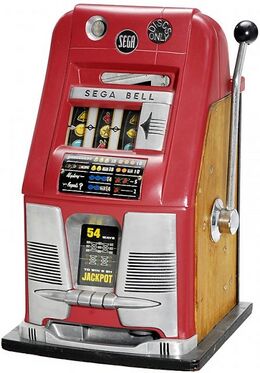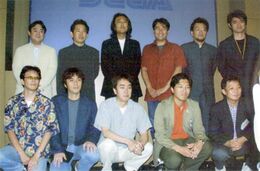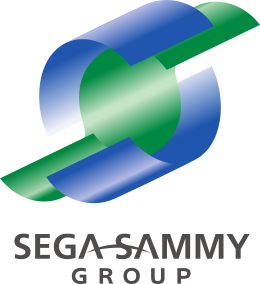History of Sega
From Sega Retro
Contents
Formation and early successes

Sega claims to have been established in 1951 (and incorporated in 1960)[1], however in reality Sega's history begins with the establishment of "Service Games", Hawaii originating in 1945 when Irving Bromberg and his son, Martin Jerome Bromberg, formed a partnership with James L. Humpert to manufacture and distribute slot machines and other coin-operated devices, primarily to US personell stationed across Asia in the years after World War II. They called the partnership Service Games (i.e military service) and based their operation in Honolulu.
Irving Bromberg, the father, brought to the young company a reputation for being an innovator in coin-machine technology; as the founder of the Irving Bromberg Co. (established in 1933), he brought some of the first vending machines to Brooklyn, Boston and Washington, D.C. He also founded a business known as Standard Games Co. in Los Angeles, California, in 1934 for the civillian market. However, he was aging and his son assumed much of the management of Service Games. Bromley and Humpert were employed in the U.S. Navy Shipyard at Pearl Harbor during World War II, and had worked together in coin-operated enterprises that called upon the technical competence of the senior Bromberg.
The United States Congress of the Gambling Devices Transportation Act of 1951 banned slot machines on military bases within the territory of the United States, forcing Service Games to look into other avenues to market and sell their products. In February 1952, Bromley sent Richard Stewart, a Service Games salesman, and Raymond Lemaire, a mechanic, to Japan to promote and expand sales of Service Games machines on U.S. military reservations.
The result, Service Games, Japan, and over the next few years, a network of factories sprung up across South East Asia to cater for American troops stationed in the Orient. Service Games also began selling its machines in Europe, becoming one of the major players in the worldwide slot machine market.
By the early 1960s a series of money-making sell-offs left only the Japanese branch of Service Games still in operation, and in May 1960 had split into two entities, Nihon Goraku Bussan (distribution) and Nihon Kikai Seizo (manufacturing). The "Service Games" brand was no longer in use, but a condensed brand name was used by the latter - "Sega", first seen paired with the successful Sega 1000 jukebox.
The merge
The Korean war had seen American businessman and former Air Force officer David Rosen stationed in Japan, and having fallen in love with the country, returned in 1954 to establish Rosen Enterprises, Inc.[2]. Originally an art exporting business Rosen's company stumbled upon a surprise hit when it began to import coin-operated instant photo booths from America, tapping into the Japanese need for photographs as proof of identity.
As Japanese living standards began to rise, Rosen moved into the arcade business, importing electro-mechanical games from Chicago. By 1961, the American arcade industry had declined, due to stagnation and lack of innovation from Chicago manufacturers. This led to Sega producing its own electro-mechanical arcade games, with engineer Hisashi Suzuki leading development, along with assistance from other Japanese engineers at Nihon Goraku Bussan.[2][3]
Soon Rosen had a presence in 200 Japanese arcades, and he sought out competitors in the interests of merging. Talks with Bromley at Nihon Goraku Bussan proved fruitful, and the two sides became Sega Enterprises Ltd. in 1965 ("Sega" borrowed from the Nihon Goraku Bussan side, and "Enterprises" coming from Rosen)[4].
Gulf+Western

Equipped with brand recognition, strong distribution channels and a large arcade presence, Sega's import business boomed, and soon found itself producing its own games, starting with the 1966 smash hit, Periscope. Proving that a non-American company could make gains in the coin-op industry, Sega was acquired on May 3, 1969 by media conglomerate Gulf+Western. This opened the door for Sega to enter other arenas, importing both American-made pinball tables (before manufacturing its own starting with Winner in 1972) and Rock-Ola jukeboxes.
Being a company involved in the business of entertainment, it was only a matter of time before Sega would look into video games. Seeing the success of Atari's Pong, Sega branched out into video game importing and later development, allying themselves with Gremlin Industries in North America. As electro-mechanical games were displaced, Sega began to make a name for itself through games such as Turbo and Zaxxon, as well as through distributing Frogger in the States.
Seeing the potential, 1984 saw Rosen and a group of outside investors (including Hayao Nakayama, Shoichiro Irimajiri and the chairman of CSK, Isao Okawa) bought back Sega, and as an independent company once more, continued to expand rapidly into the 1980s.
| This article needs to be rewritten. This article needs to be rewritten to conform to a higher standard of article quality. After the article has been rewritten, you may remove this message. For help, see the How to Edit a Page article. |
Third Party Existence

On March 21, 2001, what was once unthinkable was finally a reality. Announcing their focus on software only two months prior, the first Sega game to be released on a Nintendo console became available. Being a port of the Dreamcast title Chu Chu Rocket on the Game Boy Advance, it was only the first of many titles to be released on hardware Sega once considered the competition. Any game early enough in development was moved from the Dreamcast to other hardware, and existing titles were quickly ported over to try and recoup the losses Sega had been incurring.
Only two days before, Isao Okawa, President of Sega Japan, passed away, only days after donating $695.7 million USD to the company in an effort to get it out of the red. Even still, the fiscal reports released in March 2002 still put the company below the line of profitability for the fourth straight year. Although not nearly as far in the red as it had been the year previous, it was still painfully obvious that even after dropping out of the hardware market, that company was still in serious financial trouble. Though Okawa had briefly talked with Microsoft about the possibility of having Sega merge with their gaming division before his death, nothing had come of those talks.
Also in early 2001, it was announced that Sega had plans to port Saturn games over to the original PlayStation. A GameWeek interview conducted with Charles Bellfield (Sega's VP of marketing) at Toy Fair 2001 in New York revealed that Sega would announce specific Saturn title ports in April to be released in summer 2001.[1] The Saturn ports would be priced at $19.99.[2]
Two games were eventually released by Sega on the Playstation (MiniMoni. Shakka to Tambourine! Dapyon! and Puyo Puyo Sun Ketteiban). Puyo Puyo games were released on several platforms over the years so it's presence on the PlayStation isn't that unusual. The Sega releases for the PlayStation did not come out until 2002-2003.
Though brief discussions continued on with former interests Microsoft, Bandai and even Electronic Arts, on February 19, 2003, Sega announced to the world their impending merger with Sammy Corp., who specialized in Pachinko machines. Only nine weeks after signing an agreement in principle with Sammy, gaming giant Namco made public their own intentions with Sega, making a counter offer to have Sega merge with them. Within a month, both talks fell through, with Sega withdrawing from the Sammy merger and delaying talks with Namco, which prompted that company to withdraw their offer, making it clear that it definitely was not the right time to merge if Sega did not know what it wanted to do with itself.
In August of that year, Sammy once again became interested in Sega, buying the holdings CSK still held with Sega. Once purchasing the 22 percent outstanding stock in the company, Sammy Chairman Hajime Satomi became the CEO of Sega Japan.
Sega Sammy Holdings
In the middle of 2004, Sammy bought a controlling interest in Sega, at the reported cost of $1.1 Billion USD. In the wake of this purchase, Sega Sammy Holdings was created, with Sega being a subsidiary of that company. Because of the company's restructuring, the development studios that had become semi-autonomous back in 2000 were remerged into Sega proper. One of those studios, Visual Concepts, would soon be sold to Take-Two Interactive.
Previously, Sega operated only in the "Consumer Business", "Amusement Machines Business", and "Amusement Center Business". After the merger, the "Pachinko and Pachislot Machine Business" was added and provided nearly two thirds of the revenue, providing Sega with financial stability.
In Japan, Sega's arcade market went on to go well with the multiplayer set-ups of Derby Owners Club, kids card game business of Mushiking and internet features of Virtua Fighter 4. In the console and handheld business more and more games aimed at the Japanese climbed the charts, spearheaded by the big budgeted Yakuza series. On the Western side, acquisitions of Creative Assembly and Sports Interactive and other Western partnerships resulted into solid sales. The Sonic the Hedgehog franchise continues to be popular selling millions with each title, altough the critical reception has been very mixed.
In 2012, the enviorment of the business has changed dramatically, with the arcade market declining, packaged games no longer providing the core of the companies revenue both in Japan and in the West. Sega then entered a restructuring phase with the following measures: Focusing on core franchises in the packaged game market, with a drop of 140 SKU in 2007 to 49 SKU's in 2013. Sega closed and downsized several international branches, however as a trade strengthenedtheir digital business and made further large acquisitions in the Western and Japanese market.
In the mobile business, Sega made first strides when the iPhone was released with a Super Monkey Ball app which climbed the No.1 spot in the charts. In the emerging and growing F2P market Sega made it's first strides with Kingdom Conquest in 2010. Another key strategy of the F2P market was the development and release of the PC Online game, Phantasy Star Online 2. The game became the most successfull in the franchise since it's introduction in 1987. In terms of aquisitions, Sega made a purchase with Relic Entertainment resembling it's purchase with Creative Assembly in 2005. The major Japanese acquistion came in the form of Index Corporation, which also contained Atlus, a publisher and developer of niche IP rather than the purchased million seller IP of before. Index was split into with it's video gaming business being established as Atlus.
In light of these recent changes, Sega Sammy decided to consolidate and restructure their four operating segments. The Pachinko and Pachislot segment by Sammy remained, providing the main financial strengh of the group. The "Entertainment Contents Business" contains all of Sega's businesses. The main financial strengh of the segment is the new Sega Games, the successor of Sega Corporation, which ecompasses their mobile, PC and console game´businesses. This company is headed by the son of Sega Sammy CEO, Haruki Satomi. The new "Resorts" business venture from Sega Sammy, utilizies Sega's theme park assets to promote it.
Detailed history
- History of the Sega Master System
- History of the Sega Mega Drive
- History of the Sega Game Gear
- History of the Sega Mega-CD
- History of the Sega 32X
- History of the Sega Saturn
- History of the Sega Dreamcast
References
| Sega, the company |
|---|
| Company profiles | Harmony | History | Jingle | Scream | Logo | Offices | Souzou wa Inochi | Wakai Chikara |
| Annual reports | Investor relations |

